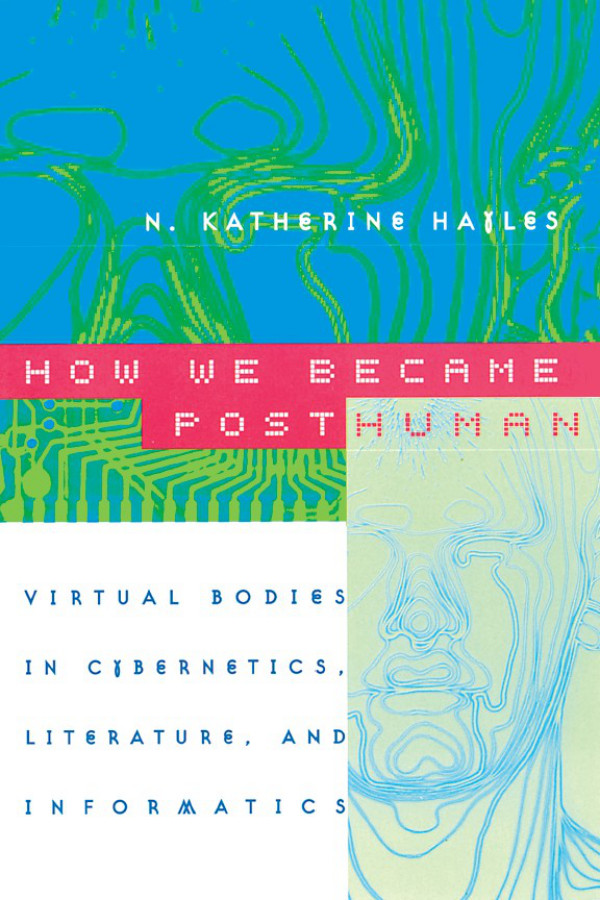N. Katherine Hayles: How We Became Posthuman: Virtual Bodies in Cybernetics, Literature, and Informatics (1999)
Filed under book | Tags: · android, artificial intelligence, autopoiesis, body, cellular automata, computing, cybernetics, cyborg, epistemology, literature, posthuman, posthumanism, technology, virtual reality

“In this age of DNA computers and artificial intelligence, information is becoming disembodied even as the “bodies” that once carried it vanish into virtuality. While some marvel at these changes, envisioning consciousness downloaded into a computer or humans “beamed” Star Trek-style, others view them with horror, seeing monsters brooding in the machines. In How We Became Posthuman, N. Katherine Hayles separates hype from fact, investigating the fate of embodiment in an information age.
Hayles relates three interwoven stories: how information lost its body, that is, how it came to be conceptualized as an entity separate from the material forms that carry it; the cultural and technological construction of the cyborg; and the dismantling of the liberal humanist “subject” in cybernetic discourse, along with the emergence of the “posthuman.”
Ranging widely across the history of technology, cultural studies, and literary criticism, Hayles shows what had to be erased, forgotten, and elided to conceive of information as a disembodied entity. Thus she moves from the post-World War II Macy Conferences on cybernetics to the 1952 novel Limbo by cybernetics aficionado Bernard Wolfe; from the concept of self-making to Philip K. Dick’s literary explorations of hallucination and reality; and from artificial life to postmodern novels exploring the implications of seeing humans as cybernetic systems.
Although becoming posthuman can be nightmarish, Hayles shows how it can also be liberating. From the birth of cybernetics to artificial life, How We Became Posthuman provides an indispensable account of how we arrived in our virtual age, and of where we might go from here.”
Publisher University of Chicago Press, 1999
ISBN 0226321460, 9780226321462
350 pages
PDF (updated on 2012-7-24)
Comment (0)Anna Everett, John Thornton Caldwell (eds.): New Media: Theories and Practices of Digitextuality (2003)
Filed under book | Tags: · aesthetics, art, cinema, computer animation, cyberpunk, cyborg, digital culture, digital media, interface, internet, media theory, new media, posthuman, programming, television, virtual reality

The mushroom-like growth of new media technologies is radically challenging traditional media outlets. The proliferation of technologies like DVDs, MP3s and the Internet has freed the public from what we used to understand as “mass media.” In the face of such seismic shifts and ruptures, the theoretical and pedagogical foundations of film and TV studies are being shaken to their core. New Media demands a necessary rethinking of the field. Writing from a range of disciplines and perspectives, the scholars here outline new theses and conceptual frameworks capable of engaging the numerous facets of emergent digital technology.
Publisher Routledge, 2003
AFI Film Readers series
ISBN 041593995X, 9780415939959
274 pages
PDF (updated on 2012-7-31)
Comment (0)Jay David Bolter, Richard Grusin: Remediation: Understanding New Media (1999)
Filed under book | Tags: · computer games, digital art, film, media, new media, painting, photography, radio, remediation, self, technology, television, ubiquitous computing, virtual reality, web

Media critics remain captivated by the modernist myth of the new: they assume that digital technologies such as the World Wide Web, virtual reality, and computer graphics must divorce themselves from earlier media for a new set of aesthetic and cultural principles. In this richly illustrated study, Jay David Bolter and Richard Grusin offer a theory of mediation for our digital age that challenges this assumption. They argue that new visual media achieve their cultural significance precisely by paying homage to, rivaling, and refashioning such earlier media as perspective painting, photography, film, and television. They call this process of refashioning “remediation,” and they note that earlier media have also refashioned one another: photography remediated painting, film remediated stage production and photography, and television remediated film, vaudeville, and radio.
Publisher: MIT Press, 1999
ISBN: 0262024527, 9780262024525
295 pages
PDF (CHM; updated on 2012-9-3)
PDF (low quality PDF; added on 2012-9-3)

